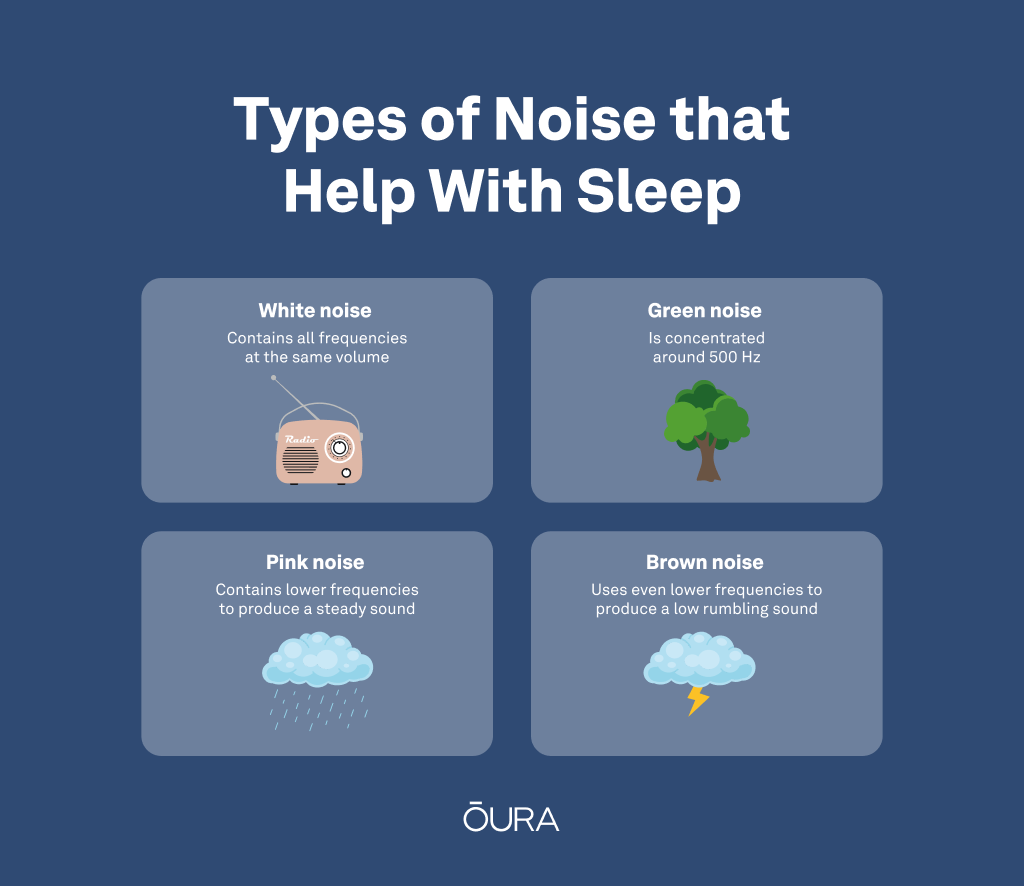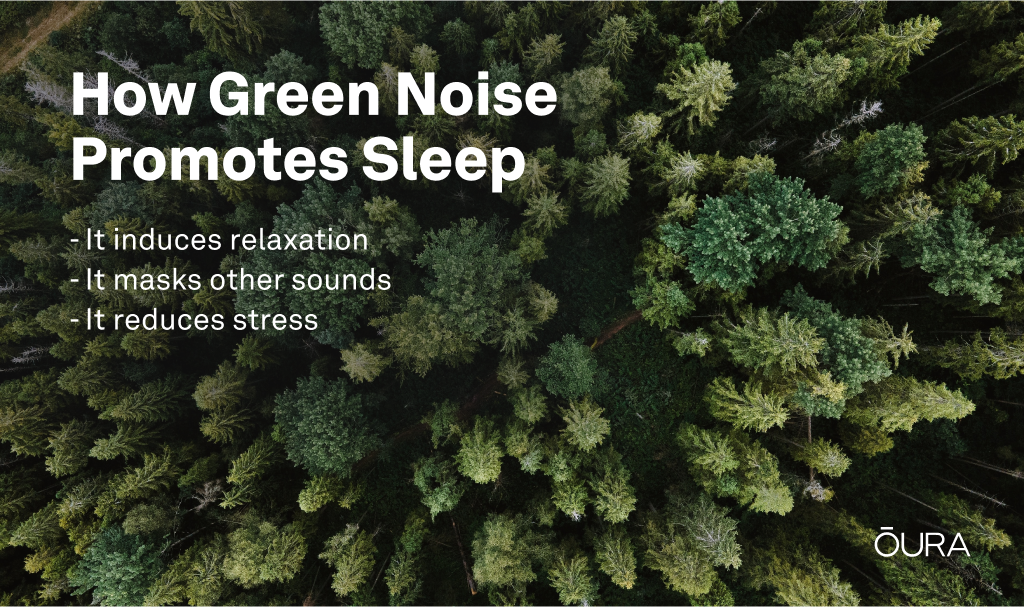You’ve probably heard of white noise as a background noise that helps everyone — from babies to people with ADHD — get a better night’s sleep.
If you’ve been hanging out on TikTok recently, you might have heard of green noise, which has been trending on the platform — the hashtag #greennoise has over 1.1 million views and counting.
So what’s the deal with all these different ‘colors of noise’, and why are so many people turning to social media to sing the praises of green noise?
Popular sleep sounds, such as green and white noise, work by drowning out other noises, such as traffic, sirens, or snoring bed partners, and providing a constant sound across multiple frequencies that can help you fall asleep more easily.
Green noise generally consists of nature sounds, such as waves on the beach or gentle rain, that mask other noises and induce feelings of relaxation, which is why many people are now incorporating it into their sleep hygiene routine.
READ MORE: 5 Ways to Upgrade Your Sleep Hygiene
Oura members can use the Tags feature to track their nighttime behaviors and habits and see how they impact their sleep quality over time, such as the white noise tag.
In the Oura App, you can also track metrics such as sleep latency (how long it takes to fall asleep) and sleep efficiency (the quality of your sleep) to see whether green noise helps you fall asleep more quickly or sleep more soundly.
What is Green Noise?
What gives a noise a particular “color” is its frequency range. White noise holds all sounds of the frequency spectrum at the same volume, with sound waves that move through lower and higher frequencies, producing a consistent sound that drowns out other noises. For examples of white noise, think of radio static, fans, and air conditioning units.
Green noise is a variation of white noise that lies at the center of the frequency spectrum and has a fairly limited range that stays around 500 Hz. Green noise has equal energy per octave and sounds like a gentle hissing sound, such as a waterfall or waves lapping on the beach.
But the different colors of noise aren’t limited to white and green. There are many others, some of which can help improve sleep quality, such as the following:
- Pink noise is similar to white noise in that it uses a consistent frequency or pitch but uses lower frequencies and deeper sound waves. Pink noise creates a flat, even sound, like steady rain.
- Brown noise (or red noise) uses even lower frequency sounds to produce a low rumbling noise, like far-off thunder.
Other types of noise that are not recommended for sleep are as follows:
- Blue noise consists of high frequencies. The power and energy of blue noise increase as the frequency increases.
- Violet noise is similar to blue noise in that it’s tuned to higher frequencies. Research indicates that violet noise may be an effective treatment for tinnitus.
- Gray noise contains all frequencies with equal loudness — as opposed to white noise, which contains all frequencies with different energy.
- Black noise is an informal way of saying silence or an absence of noise.

White, green, pink, and brown noise can all help you fall and stay asleep and improve your sleep quality.
How Does Green Noise Promote Better Sleep?
If you’re the kind of person who prefers to fall asleep with background noise, there are a few ways green noise may help improve your sleep quality. Here are three of the main ones.
It Induces Relaxation
Since green noise is usually made up of distinct sounds that are linked to nature, it can help restore a sense of calm and relaxation, making falling and staying asleep easier.
Because it has a lower frequency and fewer waveform vibrations per second than other sounds, it provides ambient noise that won’t disturb your sleep.
While more research is needed to establish the effectiveness of green noise for sleep, it’s possible that listening to green noise may have a relaxing effect similar to meditation. By promoting relaxation, green noise may improve sleep quality and help you get deeper and more restful sleep.
Oura members interested in exploring mindfulness and relaxation can access a library of over 70 guided meditations.
RELATED: Can Meditation Help You Sleep?
It Masks Other Sounds
Because green noise masks other noises that negatively impact your sleep quality, it’s useful for people who live in noisy areas or share a bed with someone who snores. Blocking out these sounds can help stop them from disturbing your sleep.
It Reduces Stress
Green noise is usually created using recorded natural soundscapes or sounds of nature. A 2021 research paper found that listening to nature sounds decreases stress, promotes relaxation, relieves pain, and improves mood and cognitive performance.
The relaxing effect of listening to nature sounds may, therefore, help people with sleep disorders improve the quality of their sleep.

How to Improve Your Sleep Quality with Green Noise
If you think listening to green noise might help you get a better night’s sleep, follow these tips to incorporate it into your routine.
Ensure It’s Right for You
Some people like to listen to gentle ambient sounds while falling asleep…and some people don’t. If you’re in the latter group, green noise might not be the best option for you.
However, if you live in a noisy area or get disturbed easily by sounds coming from inside your house, green noise can help with sound masking. Plus, its relatively low frequencies are less likely to disrupt your sleep.
Test out green noise with a Spotify or YouTube track to see if it works for you.
Oura members can use their Oura Ring data to test out theories about green noise and other factors that may affect their sleep and health.
Find the Perfect Sound Settings
Again, the ideal sound to fall asleep to is a personal preference, so test out different kinds of sounds to find what works best for you.
Some people might prefer pink sounds, such as birdsong, while others may favor green noise, like ocean waves, and some might opt for good ol’-fashioned white noise, like a ceiling fan.
You may also want to:
- Experiment with different volumes to find the level that will help you sleep.
- Use headphones to better understand the sound that will send you to sleep.
Oura members can check their Sleep Score when they wake up to see how well they sleep after listening to different types of sleep sounds.
READ MORE: How Does the Oura Ring Track My Sleep?
Be Consistent and Patient
It’s important to integrate green noise into your sleep routine in a consistent and regular manner to allow your body to become familiar with the noise. In addition, it may take some time to acclimatize to green noise, so give yourself time to adjust to it.
At first, you might find that new noises make it harder to fall asleep. If this happens, try sticking with it for a few nights to see whether the problem persists or improves.
Be patient, practice self-compassion, and don’t stress if you don’t see an immediate improvement.

Does Green Noise Help With Sleep? It Depends
While more research is still needed into the effects of green noise on sleep, it may be worth a try if you struggle with falling and staying asleep due to factors such as noise, stress, or racing thoughts.
That said, becoming reliant on green noise may make it harder to fall asleep in other situations (for example, when traveling). Therefore, it’s essential to optimize every aspect of your sleep hygiene to achieve the best sleep possible.
Oura members can identify ways to improve sleep hygiene by tracking their current sleep patterns and receive personalized bedtime guidance based on their sleep schedule and quality. They can also access the library of guided sleep meditations to help them unwind and prepare for a restful night’s sleep.
RELATED: Try Oura’s Guided Sleep Meditations for Deep and Restful Sleep










